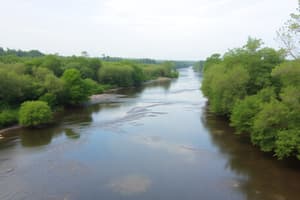Podcast
Questions and Answers
What is the approximate length of the Nile River?
What is the approximate length of the Nile River?
- 2,320 miles
- 4,135 miles (correct)
- 3,540 kilometers
- 3,915 kilometers
Which river is the longest entirely within China?
Which river is the longest entirely within China?
- Yangtze River (correct)
- Mississippi River
- Yenisey River
- Amazon River
In terms of length, which river ranks second after the Nile River?
In terms of length, which river ranks second after the Nile River?
- Yangtze River
- Yenisey River
- Amazon River (correct)
- Mississippi River
Approximately how long is the Mississippi River?
Approximately how long is the Mississippi River?
What is the primary waterway in North America?
What is the primary waterway in North America?
Which river is the longest in Russia?
Which river is the longest in Russia?
What method is used to measure the length of a river by calculating the straight-line distance between the river's banks at its widest point?
What method is used to measure the length of a river by calculating the straight-line distance between the river's banks at its widest point?
Why do longer rivers tend to have cleaner water quality?
Why do longer rivers tend to have cleaner water quality?
In terms of fish migration and dispersal of aquatic species, what advantage do longer rivers provide?
In terms of fish migration and dispersal of aquatic species, what advantage do longer rivers provide?
What is a crucial factor in determining the cultural, historical, and economic importance of a river to the communities it connects?
What is a crucial factor in determining the cultural, historical, and economic importance of a river to the communities it connects?
How do longer rivers contribute to flood control and water supply management?
How do longer rivers contribute to flood control and water supply management?
What is the purpose of the Thalweg method for measuring river length?
What is the purpose of the Thalweg method for measuring river length?
Flashcards are hidden until you start studying
Study Notes
The Magnificence of Rivers: Exploring River Lengths
Rivers are the lifeblood of our planet, carving paths through landscapes, shaping ecosystems, and connecting diverse habitats. A central characteristic of rivers is their length, which can span across miles, even continents. Let's delve into the world of river lengths, exploring the mighty waterways that have captivated explorers and scientists alike.
The Longest Rivers
-
The Nile River, stretching over 4,135 miles (6,645 kilometers) through 11 countries, is the longest river on Earth. The Nile's vast length is a testament to the power of water and erosion.
-
The Amazon River, which flows through Brazil, Brazilian Amazonas, and other South American countries, is the second-longest river at around 4,000 miles (6,400 kilometers).
-
The Yangtze River, the longest river entirely in China, snakes through 18 provinces for approximately 3,915 miles (6,300 kilometers).
-
The Mississippi River, the primary waterway in North America, stretches around 2,320 miles (3,730 kilometers) across the United States.
-
The Yenisey River, the longest river in Russia, winds through Siberia for approximately 2,200 miles (3,540 kilometers).
Measuring River Length
River length is typically measured along the channel centerline from its source to its mouth or confluence with another river. However, defining the source and mouth can be challenging, as rivers often change course and flow into numerous smaller waterways.
The length of a river can also be influenced by its seasonal flows, as some rivers dry up in certain areas during certain times of the year. To account for this, scientists often use different methods to measure the length of a river, including:
-
Bank-to-bank method: The straight-line distance between the river's banks at its widest point.
-
Thalweg method: The length of the deepest channel followed by the river's flow.
-
Channel-centerline method: The length of the river along its centerline from the source to the mouth.
The Importance of River Length
Aside from being a geographical feature, river length plays a crucial role in shaping the river's ecosystem and its function in natural processes.
-
Sediment transport: Longer rivers tend to transport more sediment, which can have a significant impact on the river's ecosystem and downstream environments.
-
Water quality: Longer rivers generally have more time to process pollutants and nutrients, resulting in cleaner water quality.
-
Connectivity: Longer rivers provide greater opportunities for fish migration and the dispersal of aquatic species.
-
Cultural and historical significance: The length of a river can be a vital factor in its cultural, historical, and economic importance to the communities it connects.
-
Flood control and water supply: Longer rivers can store more water and help in managing floods and supplying water to downstream communities.
Conclusion
Rivers, with their remarkable lengths, serve as vital arteries of our planet, nurturing diverse ecosystems and connecting vast landscapes. Knowing the lengths of our rivers is essential to understanding their ecological and geographical significance. As we continue to explore and learn more about our planet, the length of rivers remains a fascinating and crucial aspect of the natural world.
Studying That Suits You
Use AI to generate personalized quizzes and flashcards to suit your learning preferences.




